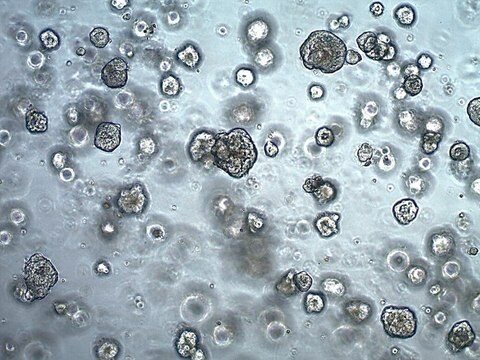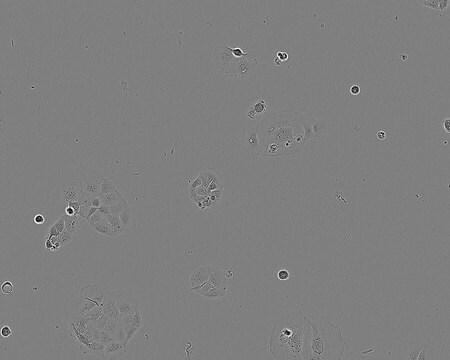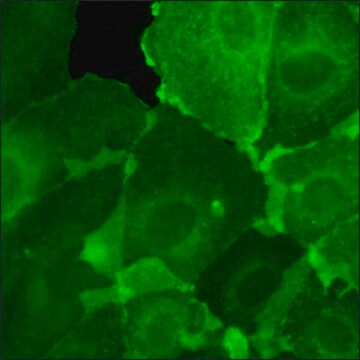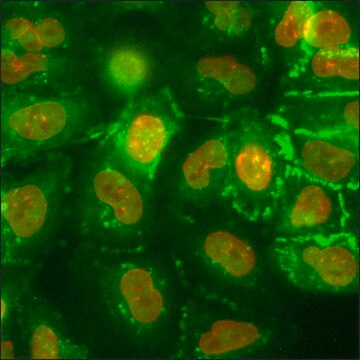Wszystkie zdjęcia(1)
Kluczowe dokumenty
CLLS1132
DLD1 CELLS AKT1 -/-
human male colon (Source Disease: Colorectal adenocarcinoma)
Zaloguj sięWyświetlanie cen organizacyjnych i kontraktowych
About This Item
Kod UNSPSC:
41106514
NACRES:
NA.81
pochodzenie biologiczne:
human male colon (Source Disease: Colorectal adenocarcinoma)
Polecane produkty
Opis ogólny
DLD1 Cells SMAD4 -/- are colorectal adenocarinoma, epithelial cells, from a human adult male, with a ZFN knock out modification.
This product corresponds to ATCC Cat. No. CCL-221.
This product corresponds to ATCC Cat. No. CCL-221.
Zastosowanie
Media Renenewal changes two to three times per week.
Rapidly thaw vial by gentle agitation in 37°C water bath (~2 minutes), keeping vial cap out of the water. Decontaminate with 70% ethanol, add 9 mL culture media and centrifuge 125 x g (5-7 minutes). Resuspend in complete culture media and incubate at 37°C in a 5% CO2 atmosphere.
Subculture ratio: approx. 1:3 to 1:10.
The base medium for this cell line is RPMI, Cat. No. R5886. To make the complete growth medium, add the following components to the base medium: fetal bovine serum, Cat. No. F4135, to a final concentration (v/v) of 10%, L-glutamine, Cat. No. G7513, to a final concentration of 2 mM and sodium pyruvate, Cat. No. S8636, to a final concentration of 1 mM.
Cell freezing medium-DMSO 1X, Cat. No. C6164.
Rapidly thaw vial by gentle agitation in 37°C water bath (~2 minutes), keeping vial cap out of the water. Decontaminate with 70% ethanol, add 9 mL culture media and centrifuge 125 x g (5-7 minutes). Resuspend in complete culture media and incubate at 37°C in a 5% CO2 atmosphere.
Subculture ratio: approx. 1:3 to 1:10.
The base medium for this cell line is RPMI, Cat. No. R5886. To make the complete growth medium, add the following components to the base medium: fetal bovine serum, Cat. No. F4135, to a final concentration (v/v) of 10%, L-glutamine, Cat. No. G7513, to a final concentration of 2 mM and sodium pyruvate, Cat. No. S8636, to a final concentration of 1 mM.
Cell freezing medium-DMSO 1X, Cat. No. C6164.
Działania biochem./fizjol.
AKT serine/threonine kinase 1 (AKT1) acts as a regulator for cell-survival and anti-apoptotic actions, which are involved in development of various cancers. This protein has a crucial role in tumorigenesis. In mice, AKT1 is essential for normal development. Mutations in the gene are associated with the pathogenesis of prostate cancer (PC). Elevated expression of the gene has been observed in human gastric cancer. Aberrations in the AKT1 and glycogen synthase kinase 3 (GSK3)-β signaling leads to the development of schizophrenia.
Cechy i korzyści
These DLD-1 cells are adherent, with a doubling time of approx. 20 hours.
Zinc finger nuclease (ZFN) knock out on chromosome 14q32.3
Zinc finger nuclease (ZFN) knock out on chromosome 14q32.3
Jakość
Tested for Mycoplasma, sterility, post-freeze viability, short terminal repeat (STR) analysis for cell line identification, PCR assay for cell line species confirmation.
Oświadczenie o zrzeczeniu się odpowiedzialności
RESEARCH USE ONLY. This product is regulated in France when intended to be used for scientific purposes, including for import and export activities (Article L 1211-1 paragraph 2 of the Public Health Code). The purchaser (i.e. enduser) is required to obtain an import authorization from the France Ministry of Research referred in the Article L1245-5-1 II. of Public Health Code. By ordering this product, you are confirming that you have obtained the proper import authorization.
Ta strona może zawierać tekst przetłumaczony maszynowo.
Tylko elementy zestawu
Numer produktu
Opis
- DLD1 CELLS AKT1 -/-
Wybierz jedną z najnowszych wersji:
Certyfikaty analizy (CoA)
Lot/Batch Number
Przepraszamy, ale COA dla tego produktu nie jest aktualnie dostępny online.
Proszę o kontakt, jeśli potrzebna jest pomoc Obsługa Klienta
Masz już ten produkt?
Dokumenty związane z niedawno zakupionymi produktami zostały zamieszczone w Bibliotece dokumentów.
Association between single nucleotide polymorphisms in AKT1 and the risk of prostate cancer in the Chinese Han population.
Liu JM, et al.
Genetics and molecular research : GMR, 16(1) (2017)
Convergent evidence for impaired AKT1-GSK3β signaling in schizophrenia
Emamian ES, et al.
Nature Genetics, 36(2), 131-131 (2004)
Akt1/PKBalpha is required for normal growth but dispensable for maintenance of glucose homeostasis in mice
Cho H, et al.
The Journal of Biological Chemistry, 276(42), 38349-38352 (2001)
AKT plays a central role in tumorigenesis
Testa JR and Bellacosa A
Proceedings of the National Academy of Sciences of the USA, 98(20), 10983-10985 (2001)
Powiązane treści
We have applied our revolutionary CompoZr Zinc Finger Nuclease technology to create an unparalleled range of genetically modified mammalian cell lines for use in areas, such as target validation, drug discovery and drug development.
Nasz zespół naukowców ma doświadczenie we wszystkich obszarach badań, w tym w naukach przyrodniczych, materiałoznawstwie, syntezie chemicznej, chromatografii, analityce i wielu innych dziedzinach.
Skontaktuj się z zespołem ds. pomocy technicznej




